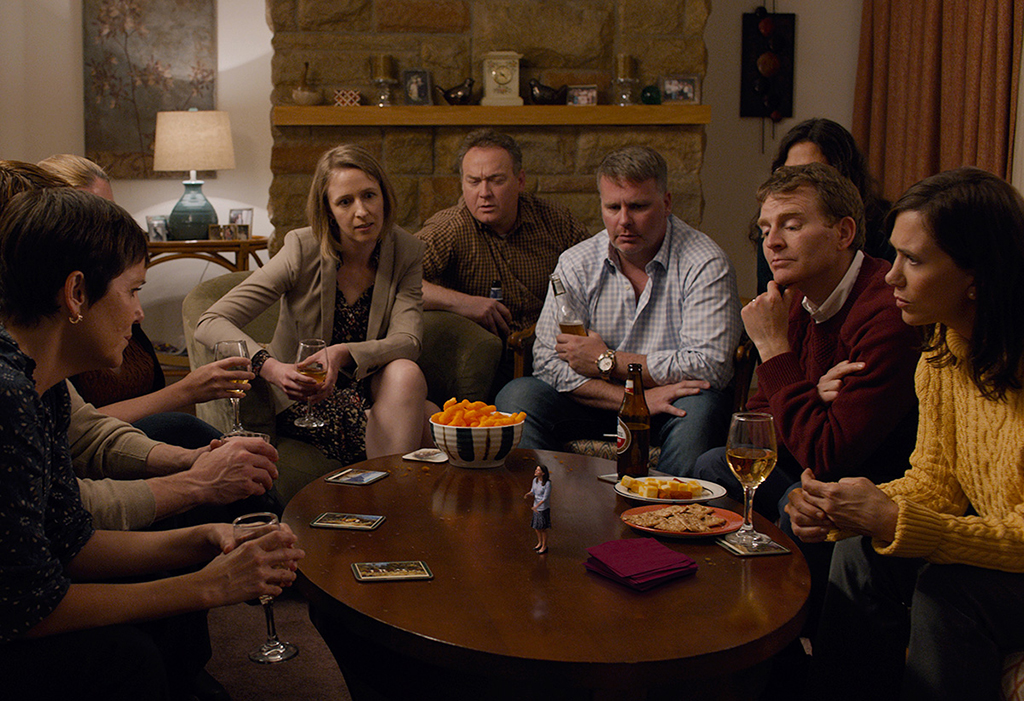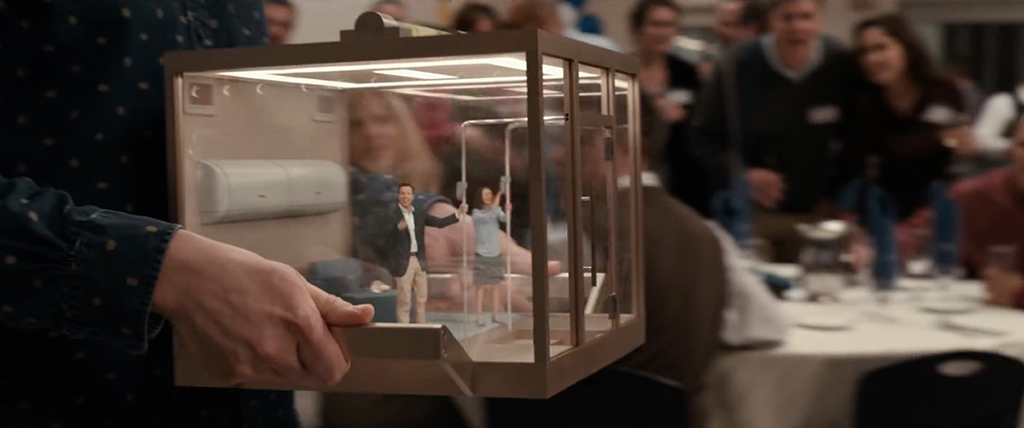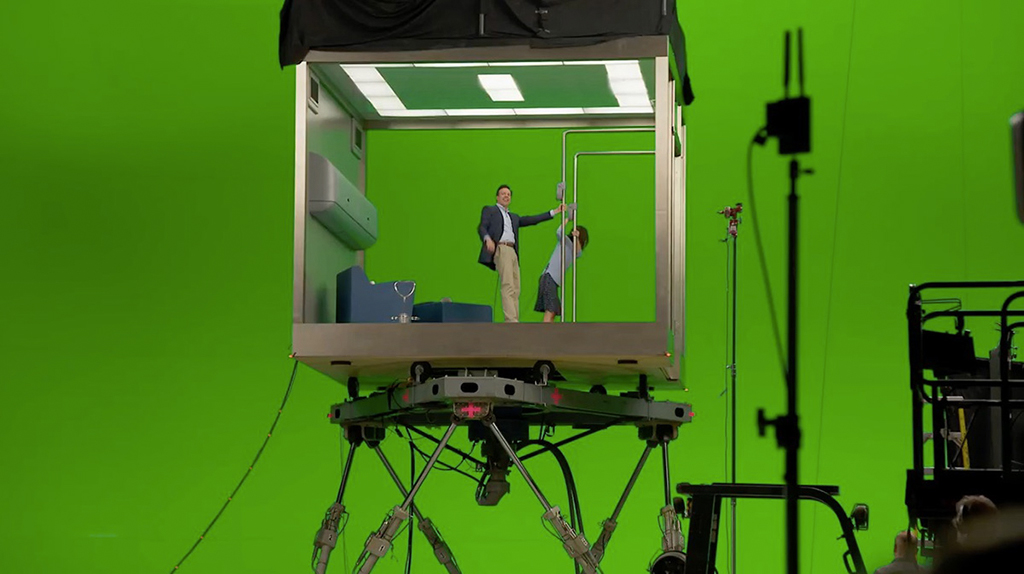By IAN FAILES
By IAN FAILES

Alexander Payne’s Downsizing dives into a world where humans can shrink themselves to about 1/14th their normal size and start new lives in ‘downsized’ communities. Visual effects played a large part in helping to show the difference between normal-sized people and small people, with various scaling tricks and methods used.
One signature shot has downsized couple Dave and Carol Johnson (Jason Sudeikis and Maribeth Monroe) arriving at a school reunion among normal-sized adults. They enter the room being carried in a container, waving and talking to their larger counterparts.
Visual Effects Supervisor James E. Price tells VFX Voice how that container shot was made possible with motion control, careful scale measurement and meticulous compositing.
“We wanted to have real performances, so we decided to solve the shot using motion control – it was the most complicated motion-control shot I’ve ever done.”
—James E. Price, Visual Effects Supervisor
In researching ways to complete the miniaturization effects, Price looked to several solutions including digital doubles. But this was not the way such shots would be handled. “We wanted to have real performances,” says Price, “so we decided to solve the shot using motion control – it was the most complicated motion-control shot I’ve ever done.”
The shot was first previsualized to work out how different elements would be brought together. The principal plate at the high school reunion involved an actor carrying a box with two dolls inside it. The camera there panned with the box across the frame. Then the Johnsons would be shot on greenscreen with motion-control inside an oversized box set.
“Because our scale was 1/14, that 14-times scale became really diabolical here,” admits Price. “10 feet became 140 feet. 20 feet becomes 280. Before you know it, you’re off the stage. We were not able to find a motion-control camera rig and enough space to actually simulate the travel of the box by moving the camera past the stationary box.”

“Because our scale was 1/14, that 14-times scale became really diabolical.10 feet became 140 feet. 20 feet becomes 280. Before you know it, you’re off the stage. We were not able to find a motion-control camera rig and enough space to actually simulate the travel of the box by moving the camera past the stationary box.”
—James E. Price, Visual Effects Supervisor
“So,” continues Price, “we actually simulated the pan by pushing into the over-scale box and then pulling back out. We built the 14-times bigger box – 14 foot by 14 foot by 14 foot – with no glass on a six-axis motion base. We tracked the movement of the box in the background plate, and then applied the motion of the box to the motion base that the over-scale set was on. Then we reversed out, essentially, the camera move and attached it to a cable cam. So imagine the 14 by 14 by14-foot box on a six-axis motion base and then a cable cam that pushed in and pulled back, which changed the distance from the camera to the box. Then the box spun as the camera pulled back. That made it simulate the pan and the distance change of the box.”
Pulling off that kind of complex shot required significant pre-planning, and Price knew early on he’d have to accommodate for a maximum distance that the cable cam could take and a maximum speed. So during the live-action background-plate shoot for the school reunion, he placed two pieces of tape about 16 feet apart on the floor.
“I told Alexander, ‘This is as much as you can have in one cut,’” says Price. “If the shot was longer than that, we wouldn’t have room to shoot the greenscreen later. We would exceed the boundaries of the stage. We had a lot of that, actually, a lot of making sure that we didn’t put our camera too high. If the camera’s 10 feet above the small person, that’s 140 feet in the air. You’re way above the stage and the ceiling of the stage. So knowing our stage availability and knowing our schedule and where we were going to shoot things, we were able to plan ahead of time and not exceed the boundaries of our greenscreen elements, which was another thing that I think contributed to the realism. We weren’t forced to cheat the perspective and shrink people down in 2D. We weren’t forced to re-light them. We really planned and made sure that everything that we did when we shot a background plate would be achievable when we shot the greenscreen plate later.”

“We were able to plan ahead of time and not exceed the boundaries of our greenscreen elements, which was another thing that I think contributed to the realism. We weren’t forced to cheat the perspective and shrink people down in 2D. We weren’t forced to re-light them. We really planned and made sure that everything that we did when we shot a background plate would be achievable when we shot the greenscreen plate later.”
—James E. Price, Visual Effects Supervisor
The filmmakers were also able to watch a live real-time composite of the shot on the greenscreen set to check that things lined up with the background high school reunion plate (which, luckily, it did). What also sells the scale differences in the shot is the approach to lighting, which was also worked out ahead of time.
“The carry box in the high school reunion was a particular lighting challenge because it was moving across a space,” notes Price. “There was a light inside the box that was the dominant light source for the characters, and also the room was fairly broadly lit. One thing that helps a lot when you have small subjects is that the light sources by definition are very broad because they’re so much bigger than the subject. So we were able to simulate that broad light on set because the sort of dominant source was from the box; it moved with the characters, and they were able to be integrated.”